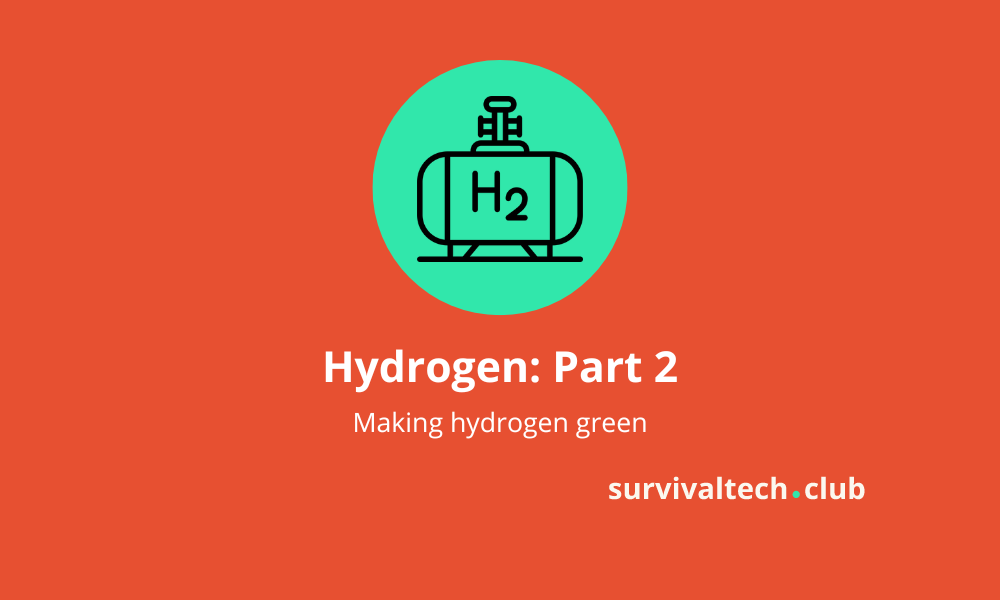Hydrogen: Part 2 #39
Making hydrogen green
Hi Human,
In Part 1 of this hydrogen series, we learned that green hydrogen currently makes up only 0.03%(!) of the global hydrogen (H2) production.
It also costs much more than fossil-based hydrogen. The cost of green H2 is 3-8 $/ kg H2, while you can buy fossil-based hydrogen for 0.5 $/ kg H2.
In the next decades, we need to ramp up the green H2 production and bring the cost of green H2 down. Fossil-based hydrogen makes no sense for the climate, even with CO2 capture (blue hydrogen).
In this Part 2, we will explore the production of green hydrogen via electrolysis, the different types of electrolyzers, and the parameters affecting the cost of green hydrogen.
Follow Survivaltech.club on Twitter and Linkedin💚
Updates
Diamond List is looking for more European and Nordic climate investors to join and nominate top early-stage climate startups. Investors: apply to become a nominator here. Here’s an article about Diamond List by Canary Media. [Note: The Diamond Lists launch party in SF this May was amazing!]
I got introduced to a new climate newsletter The Triple Bottom by Ollie Potter!
Wow, there are many of us! Survivaltech.club has +800 subscribers learning about deep tech climate solutions and startups. Awesome!💫🤩
Making green hydrogen
Green hydrogen is produced from fresh water with renewable electricity via a process called electrolysis.
The electrolysis process splits a water molecule into hydrogen and oxygen with renewable electricity. The electrolysis is run by a machine called an electrolyzer.
Making one kg of green hydrogen requires 9 kilograms of fresh water in optimal conditions. However, due to inefficiencies in the process, we need typically 18-24 kg of water per one kg H2.
The required electricity for making one kilogram of hydrogen depends on the efficiency of the electrolyzer and the surrounding system that the electrolyzer needs to function.
The required electricity ranges currently from 45 kWh to 83 kWh per one kg of hydrogen. That’s around as much energy that you can store in Tesla Model 3!

To learn in more detail about the electrolysis process, check out this video.
Types of electrolyzers
There are four main types of electrolyzers:
Alkaline
Polymer Electrolyte Membrane (PEM)
Anion Exchange Membrane (AEM)
Solid Oxide (SOEC)
Alkaline and PEM electrolyzers are the most common types of electrolyzers and are produced on a commercial scale.
The AEM electrolyzers are catching up in development and production. The AEM production ramp-up is spearheaded by a German startup, Enapter, which is building an AEM mass-production facility in Germany.
The SOEC electrolyzer is deployed only at a small scale but holds a promise for the future as one of the high-efficiency electrolyzers.
Comparison of electrolyzers
All of these four electrolyzers produce hydrogen from water and electricity but work in slightly different ways as the names suggest. Thus, the electrolyzers have different performance metrics.
This chart compares the different electrolyzer technologies based on four key metrics: 1) Pressure, 2) Efficiency, 3) Lifetime, and 4) Capital cost.

If you want to learn about the technical differences and the resulting key advantages and disadvantages of each electrolyzer type, check out Chapter 2 of this IRENA report.
Cost of green hydrogen
Fossil-based hydrogen is currently not so surprisingly the cheapest.
Producing hydrogen from natural gas costs 0.5-1.7 $/kg H2, while hydrogen via electrolysis costs 3-8 $/kg H2 depending on the geographical location.
To make green hydrogen competitive with fossil-based hydrogen, the cost of green hydrogen has to come down dramatically.
Two key factors that affect the cost of green hydrogen:
Renewable electricity cost
Electrolyzer cost
The below diagram illustrates the step changes that need to take place for green hydrogen to achieve 1$/kg H2 production cost and thereby, cost competitiveness with fossil-based hydrogen.

1. Renewable electricity cost
IEA estimates that renewable electricity costs can make up 50-90% of the green hydrogen’s total production expenses (IEA, 2021). Thus, reducing the cost of renewable electricity will be critical.
The lower we can push the price of renewable electricity, the cheaper green hydrogen will be.
It is important to note that cost reduction in electrolyzers alone cannot compensate for high renewable electricity prices. A low price of renewable electricity is a must for pushing down the cost of hydrogen.

How reachable is the 20$/MWh electricity price? Explore more here.
As the production of green hydrogen requires renewable electricity, it follows that green H2 production is likely to concentrate on areas with high renewable energy resources. This means places where the sun shines and where the wind blows constantly around the year.

2. Electrolyzer cost
The electrolyzer cost is the second largest cost component of green hydrogen production.
IRENA estimates that the cost of electrolysis plants could fall by 40% in the short term and 80% in the long term. This cost reduction is a result of factors like high economies of scale, use of cheaper materials, and learning rate.
Pioneers in green hydrogen production
More about green hydrogen
Didn’t get enough green hydrogen? Check out these resources:
Catalyst podcast by Shayle Kann: Hydrogen, meet salt cavern.
My Climate Journey podcast by Jason Jacobs: Startup Series: Electric Hydrogen.
Gniewomir Flis’ thread on electrolyzer and fuel cell efficiency.
I’d love to hear your thoughts on the green hydrogen economy! Message me at pauliina@survivaltech.club
If you liked this article, please share it with your climate friends!🌍
Best, Pauliina💚
Sources
Hydrogen Council and McKinsey & Company (2021). Hydrogen Insights. A perspective on hydrogen investment, market development and cost competitiveness. Link.
IEA (2021). Global Hydrogen Review 2021. Link.
IRENA (2020). Green Hydrogen Cost Reduction: Scaling up Electrolysers to Meet the 1.5⁰C Climate Goal, International Renewable Energy Agency, Abu Dhabi. Link.
IRENA (2021). Renewable Power Generation Costs in 2020, International Renewable Energy Agency, Abu Dhabi. Link.


